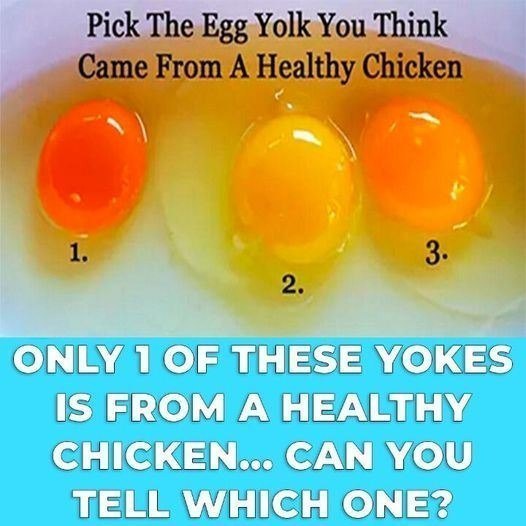Cooking with eggs is a cornerstone of many recipes, whether you’re whipping up a breakfast omelet, baking a cake, or making a creamy custard. However, not all eggs are created equal. The quality of your eggs can significantly impact the flavor, texture, and nutritional value of your dishes. Selecting eggs from healthy chickens is the key to achieving great results, and understanding a few simple tips can help you choose the best ones for your kitchen.

Why Yolk Color Matters
One of the easiest ways to gauge the quality of an egg is by looking at the color of the yolk. Most eggs have yellow yolks, which are a reliable sign of a healthy egg. However, yolk color can vary depending on the chicken’s diet and living conditions, offering valuable clues about the egg’s quality.
For instance, chickens that consume a balanced and nutrient-rich diet tend to produce eggs with yolks that are vibrant in color. On the other hand, a pale yolk might indicate that the chicken’s diet lacked variety or essential nutrients. By paying attention to these subtle differences, you can make more informed choices about the eggs you use in your cooking.
Free-Range vs. Store-Bought Eggs
When choosing between free-range and store-bought eggs, it’s important to consider the living conditions of the chickens that laid them. Store-bought eggs, which are often produced by chickens raised in more confined environments, typically have yolks that are light yellow in color. While these eggs are generally fine for most recipes, they may not offer the same nutritional value as their free-range counterparts.
Free-range eggs come from chickens that have access to the outdoors, where they can forage for natural foods like grass, seeds, and insects. This diverse diet often results in eggs with yolks that have a deeper, richer color. These eggs tend to be healthier, as they contain higher levels of vitamins and omega-3 fatty acids, which are beneficial for heart health and brain function. Additionally, many people find that free-range eggs have a superior flavor, making them a worthwhile choice for dishes where the taste of the egg is prominent, such as scrambled eggs or quiches.
The Significance of a Bright Orange Yolk
A bright orange yolk is often considered the gold standard for egg quality. This vibrant hue indicates that the chicken’s diet was not only nutrient-rich but also varied, likely including natural sources like greens, seeds, and insects. Eggs with bright orange yolks are typically packed with essential nutrients such as beta-carotene, which is converted into vitamin A in the body and supports healthy skin, vision, and immune function.
In addition to their health benefits, eggs with bright orange yolks often have a richer, more satisfying flavor, making them a favorite among chefs and home cooks alike. These eggs can elevate your dishes, adding depth and color to everything from sunny-side-up eggs to pasta carbonara.
Understanding Dark Yolks
While bright yolks are ideal, you might occasionally come across eggs with darker yolks. These darker shades can sometimes indicate that the chicken’s diet was lacking in certain nutrients or that it was raised in less-than-optimal conditions. However, it’s important to note that dark-yolked eggs are still safe to eat. They can be used in cooking and baking just like any other egg, but they might not provide the same level of nutritional benefits as eggs with vibrant orange or yellow yolks.
If you notice that your eggs consistently have dark yolks, it might be worth exploring other options, such as purchasing eggs from local farmers or switching to free-range or pasture-raised varieties. Supporting farmers who prioritize the health and well-being of their chickens can not only improve the quality of your eggs but also contribute to more sustainable and humane farming practices.
Practical Tips for Selecting the Best Eggs
When shopping for eggs, consider these practical tips to ensure you’re getting the best quality:
- Check the Packaging: Look for labels such as “free-range,” “pasture-raised,” or “organic” to identify eggs from chickens that were raised in healthier, more natural environments.
- Inspect the Shells: Choose eggs with clean, uncracked shells, as this can indicate freshness and reduce the risk of contamination.
- Pay Attention to Yolk Color: Once you crack an egg, take a moment to observe the yolk. A bright yellow or orange hue is a good sign of a nutrient-rich egg.
- Buy Local When Possible: Eggs from local farms are often fresher and may come from chickens raised in better conditions than those on large-scale commercial farms.
- Experiment with Brands: Try eggs from different brands or farmers to find the ones that consistently meet your standards for taste and quality.
Making Better Choices for Your Kitchen
Choosing high-quality eggs is about more than just aesthetics—it’s about enhancing the flavor, texture, and nutritional value of your meals. By paying attention to yolk color and understanding the differences between free-range and store-bought eggs, you can make more informed decisions that benefit both your health and your cooking. Whether you’re preparing a simple breakfast or an elaborate dessert, starting with the best eggs can make all the difference.
Incorporating these tips into your shopping routine is a small but impactful step toward elevating your culinary creations. The next time you crack open an egg, take a moment to appreciate the vibrant yolk and the care that went into producing it. Quality ingredients are the foundation of great cooking, and with the right eggs, your dishes are sure to shine.